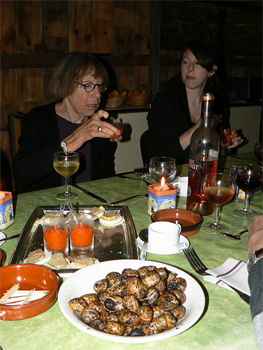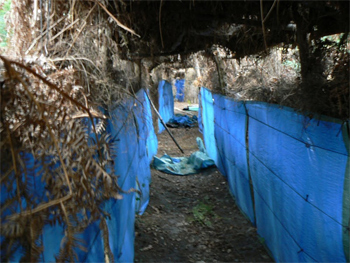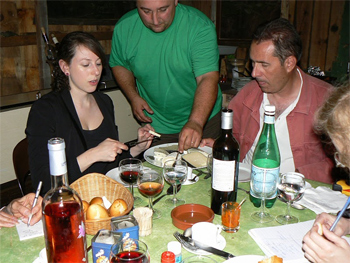
A Hunter’s Hideaway, or Palombiere, is a great place for a Country Dinner in Gascony, France
By Max Hartshorne
GoNOMAD Editor

In Southwestern France, one of the largest pine forests in Europe covers a wide swath of sandy land.
Deep in this lush forest between Bordeaux and Bayonne are small birds called palombes, which are hunted in a traditional way by groups of men who pay dearly for the privilege.
Palombieres are where you hunt these birds.
Following the Traiteur
One overcast night in June, we followed a man named Eurl Jean-Marie Bitaube whose business card read ‘Traiteur of Vianne” into the forest. He parked his small white truck in a makeshift garage covered with tree branches as if to be camouflaged from view.
We walked down a path through the trees and it was silent–only the noises of the birds and the sounds of our footprints on the sandy track.
We were following the path to the palombiere, where men from all over France bond over a ritual that goes back for centuries, and to this day remains as challenging as it was ages ago.

There are palombieres in many locations in this part of Southwestern France, and some can be visited by the public. Others, like this one, remain members’ only sanctums, and places for male bonding at its best.
The Palombiere, Where the Hunting Happens
The palombiere is a series of six-foot-high tunnels, covered from the outside with branches, and created with blue tarps and lumber. The tunnels stretch out about 100 feet in each direction all facing a central clearing. Bitaube showed us two lines of horizontal wire.
“We attach nets to this,” he said, pointing down to the two wires about thirty feet long. “People walking in the woods have errantly stepped into these traps,” he said, and the results can be fatal.
“This snaps shut very quickly; it can be very dangerous if you’re caught in it. It will easily snap your neck.
The contraption he was describing is an ancient way to catch birds called palombes. They are similar to pigeons but larger. But the birds are not hunted this way. These victims, who are attracted to corn and water placed inside the net as the men hide in the blinds, are to be used as live decoys to attract other palombes, who will be the prey.

These decoy birds, said Bitaube, will have their tiny feet tied together and be strung up a series of wires that run fifty feet up toward the tops of the trees. They will fly up the wire, bound by the string, and attract the others.
Decoy Birds
There are other ways the hunters try to attract the birds using the decoys, he said, showing us a paddle with a long handle. “We attach the decoy birds to this paddle and someone pulls it down the ground as if they are landing to eat the corn.
It’s all done from behind the blind, to fool the palombes into believing it’s a safe place to have a bite and get a drink.
“It can be minutes, or even hours,” Bitaube explained. “We wait until the perfect moment and then ‘WACK” the net flips up and we catch our decoy birds. There could be a dozen, or there could be six. We wait.
“Here you have to be completely silent, for a long time,’ he said. “You cannot be talking on the phone–“hi daddy!”– he mimicked. It was radio silence in the blind, for however many hours it would take to attract the tiny prey to within shooting distance. Once the decoys were active, the silence continued.
Hunters Only Get One Shot Each
It was clear that this traditional way of catching the decoys was as much a part of the hunt as the one shot each one could take at the flying prey. They catch the decoys and use them all year, he said. They keep them alive in large pens in the nearby towns.

At the end of the season, which runs from September to November, the decoy birds are released, having served their purpose.
Each hunter is permitted just one shot. Not any more. They all fire at once, with one lead hunter counting silently one….two…three. BANG!
I asked him how many birds are taken at this camp, and he answered only 50 to 100 per season. It was clear the odds were in the bird’s favor, and that it would be a long, long time before this species would ever be endangered– least by this tough process of elimination.
A Cozy Candlelit Lodge
At the end of one of the tunnels, we came to the main lodge, a big cozy room lit by candles with small windows looking out at the hunting area. A big table was set and three kinds of wine sat waiting– a local rose, a cabernet from Buzet, and a crisp white.
It was time for snails. A small gas stove was lit with several bubbling pots. He had begun the cooking before he came to get us at our hotel ten miles away in the town of Barbaste.

Escargot is a traditional repast in these lodges, Bitaube said. We sat down at the table and he brought forth two large bowls filled with garlicky escargot, which he said came from Marseilles, where they are farmed like mussels. Picking up toothpicks, we set to work plucking the tender insides from the tiny snail shells.
A Bountiful Bucket of Snails
It was a bounty compared with the meager portion of six traditionally presented on a plate in an expensive French restaurant. Here, dozens of roasted delicious appetizers lay before us. We couldn’t come close to finishing them but we gave it our best hunter’s effort, taking one after another out of their shells.
The rose was a semi-dry variety from Gascony and the Buzet red was fruity—a perfect complement to the briny flavor of the escargot. He brought out some crackers topped with the local duck foie gras to accompany the snails.
The Hen in the Oven

Bitaube had a hen in the oven and brought forth the main dish, a Gascony classic called Poule au Pot, once enjoyed by local favorite French King Henry IV.
It’s a long-cooked stewing fowl, combined with potatoes, and carrots and topped with a sauce of mushrooms.
It was another traditional dish served in his lodge, a bit gamier than a regular roast chicken, and darker with a rich flavor. It cooks for two hours, getting all of that stubborn egg layer’s meat nice and tender.
A woman in our group began to sing a drinking song she had learned at summer camp, which seemed appropriate as we stared down the six bottles of wine before us. She remembered every ribald verse, right to the end as we drank heartily.
Bitaube told us about his clientele, who come from all over France to enjoy time in this lodge and to partake in this ancient way of hunting. He pointed to the fireplace that would usually be ablaze and explained that this summer has been so dry, they weren’t allowed to light it due to the danger of forest fires.
The Palombiere: It’s A Man’s World
It was a man’s world here but the women felt as comfortable around the table as we did. He showed us an opening with a small window where the hunt leader controls the mechanism to raise and lower the decoy birds on the paddles.
It was time for coffee and a dessert, again following the Gascony gastronomic traditions. But first, cheese—a tangy goat cheese, a Camembert, and a local cow’s milk cheese with a thick rind.
Then he brought us a small bowl of tender peaches topped with local prunes. As we finished our coffees and thanked him for sharing this world with us, it was time to find out way out of the blind.
Sated and Content: No Birds Died
We walked the path through the dark woods, sated and content. No birds had perished from our gunshots, as I suspect is the case with most of Bitaube’s clients.
But that’s not really the point of coming here anyway.
Eurail Passes: What to Know about Buying a Europe Train Pass
- Exploring California’s Empty Central Coast - April 24, 2024
- Skiing in Georgia - February 21, 2024
- Exciting Rail Travel News in 2024 - February 4, 2024





